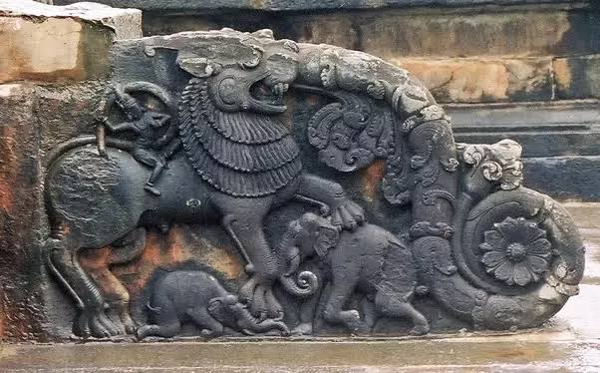The Yali in Indus Art
Mohenjo-daro seal M-300 depicts a composite animal with a pair of horns, the tusks and trunk of an elephant, lion’s mane, the graceful body of an antelope, the hind legs of a tiger, and an upright serpent-like tail.
Mohenjo-daro Seal M-300 depicting the composite animal known as Yali or Vyala
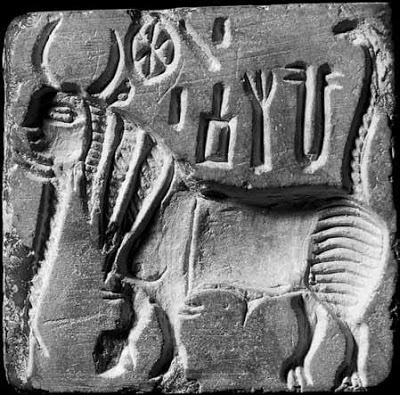
There is a strong resemblance between this composite animal and the mythological animal called Yali or Vyala which is depicted at the entrances of many Hindu temples, particularly those of Southern India, and to a lesser extent in Eastern and Central India.
The Yali or Vyala is a composite animal, most commonly depicted with a pair of horns, the tusks and trunk of an elephant, the manes and graceful body of a lion, and the tail of a serpent. In this form it is called a gaja-vyala i.e. elephant-vyala.
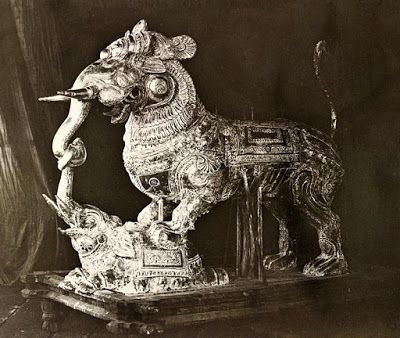
It is easy to see how closely these two images correspond. Both the composite animals have an elephant-like trunk with tusks, horns on the head, lion-like manes, a graceful cat-like body, and an upright serpent-like tail. The correlations become even more apparent when we place these figures side-by-side as shown in the image below.
This leaves little doubt that the Indus people were familiar with the symbolism of the Yali. It shows that many elements of Hindu sacred art had their origin in the art, culture, and religious beliefs of the Indus people.
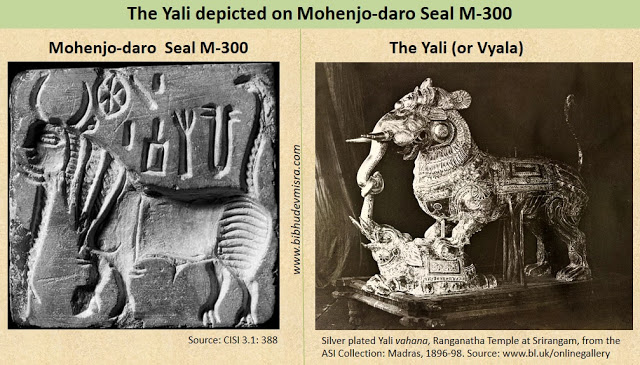
In addition to the gaja-vyala or elephant-vyala, the Yali is also frequently depicted with the face of a lion, in which case it is called a simha-vyala i.e. lion-vyala. The gaja-vyala and the simha-vyala are the two predominant forms in which the Yali is represented in temple sculptures throughout India. Very often, a rider is shown seated atop the Yali. He is generally depicted in the form of a warrior holding a weapon such as sword, bow, spear, dagger etc.
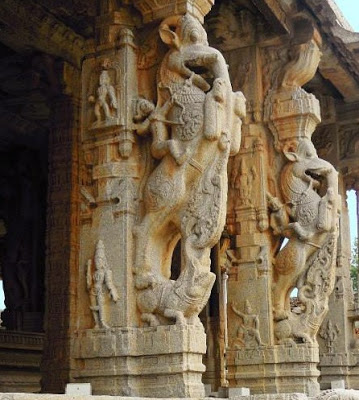
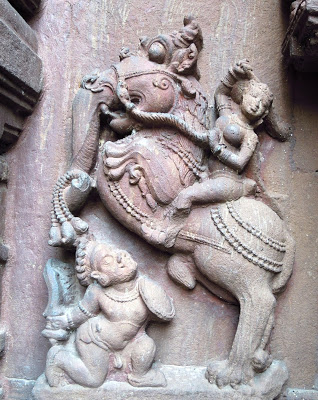
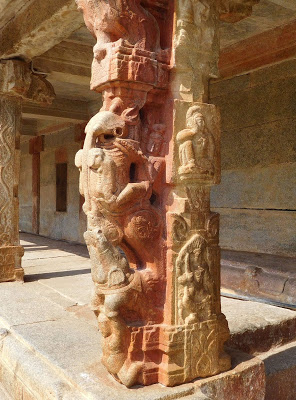
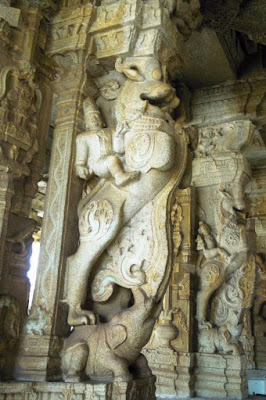
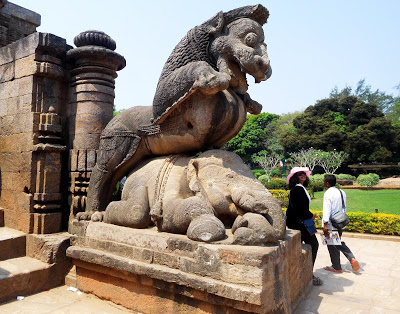
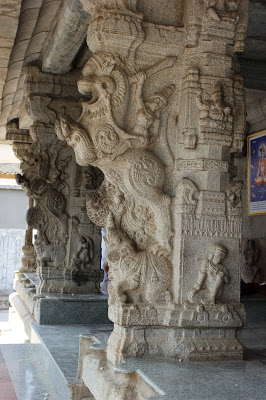
Although the Yali is generally sculpted on the temple pillars, they can also be seen carved on the temple walls. The animal is revered for its ferociousness and strength. It is believed to act as a protector and guardian of the temple, keeping evil influences out.
In spite of the fact that the Yali figure can be found in profusion in Indian temple architecture, its real significance remains shrouded in mystery. How did such a fantastic, composite, animal acquire so much importance as a protective figure in temple architecture? Is it possible to explain the origin of this symbol from the perspective of Hindu symbolisms and mythology?
Singhamukha and Tarakasura
The Hindu temple with its towering spire symbolically represents the cosmic Mount Meru – the abode of the gods. This is the central place from where Indra, the King of the Gods, extends his supremacy over the entire cosmos.
Since the Yali – along with the warrior figure perched on its back – is stationed at the entrances to the temple, acting as a protector of the sacred sanctuary of the gods, it suggests that the Yali rider could be a member of the gods’ “army”. More specifically, the Yali rider could be the archetypal warrior-god Kartikeya, also known as Skanda or Murugan. Kartikeya is General of the Gods, who protects and sustains the heavenly realms with his indefatigable energy.
While the spear or vel is the favorite weapon of Kartikeya, with which he destroys the darkness of ignorance, he also holds the sword, the bow, the thunderbolt, and the axe, all of which symbolize his diverse powers. The Yali rider wields similar weapons.
If we assume that the Yali rider is Kartikeya, then the question is, what does the Yali represent? Is it not true that the peacock is the pre-eminent mount of Kartikeya?
A clue to this problem can be found in the mythology of Murugan, as given in the Tamil scripture Kandha Puranam.
The story revolves around the circumstances of Murugan’s birth and his eventual defeat of the demons Surapadman, and his two younger brothers – Singhamukha, the asura with the face of a lion, and Tarakasura, the asura with the face of an elephant. Murugan, however, did not destroy the asuras, but subdued them and transformed them into animal vahanas, such that they became divine forces of cosmic harmony.
Thus, Surapadman was transformed by the power of Murugan’s vel into a peacock and a rooster, which became his vahana and flag-emblem respectively. Singhamukha, the lion-faced asura, and the younger brother of Surapadman, was transformed into the lion-vahana of Parvati. However, it appears that Singhamukha served not only as the mount of Parvati, but also as the mount of Kartikeya – the deity who had subdued and transformed him. In fact, in some temples of Tamil Nadu, Murugan is depicted as a lion-riding deity.
Tarakasura, the elephant-faced asura, who boasted that he was as powerful as a lion, was also defeated by Kartikeya. The Kandha Puranam does not explicitly mention his transformation, but given Kartikeya’s penchant for transforming his adversaries into vehicles of cosmic good, Tarakasura may have been transformed into the gaja-vyala, and served as a vahana of Kartikeya. In fact, in his form as Brahma-Sastha, Kartikeya rides an elephant.
Thus, the two primary forms of the Yali – the gaja-vyala and the simha-vyala – can be understood as the transformed forms of the elephant-faced demon Tarakasura, and the lion-faced demon Singhamukha. Since both the brothers were giant, powerful, asuras, the Yali was depicted in such a huge, ferocious form with horns and large, bulging eyes.
Interestingly, the Kandha Puranam mentions another asura called Yaalimukha (i.e. asura with face of a Yaali) who was the gatekeeper of Surapadman’s heavenly city. He was killed by Veerabahu, the general of Murugan’s army. However, we do not know what Yaalimukha looked like, or if he was transformed into a vahana after his death. Nevertheless, the fact that the term Yaalimukha occurs in the Kandha Puranam suggests that the Yali must be linked with the exploits of Murugan.
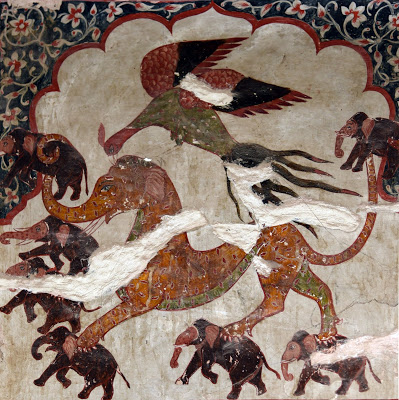
A particular depiction of the gaja-vyala at the Orchha Fort supports this contention. It shows a large bird with elongated tail feathers, resembling a peacock, attacking the gaja-vyala. This is consistent with the information in the Kandha Puranam, for the peacock was a transformed form of the asura Surapadman who was the elder brother of Simhamukha and Tarakasura, and the most powerful of all the asuras. Thus, the peacock, although a bird, would be more powerful than either forms of the Yali – the simha-vyala or the gaja-vyala.
We must remember, though, that mythological animals such as the Yali, or birds such as the peacock-mount of Kartikeya, possibly represent cosmic entities, and do not refer to terrestrial animals. One explanation could be comets, for comets have been historically visualized in the form of animals and birds. One of the terms that the Chinese used for comets is “long-tailed pheasant star”, since the pheasant has a long tail feathers, resembling the long tail of a comet. Ancient Chinese astronomical records described comet tails using terms such as “snake-like”, “winding like an earthworm”, “dragon-shaped” etc. The Roman philosopher Pliny described a “hippeus” or “horse” comet, having plumes like horses’ mane, probably referring to the curvy, white dust tail of a comet.
It is well-known that comets have periodically smashed onto the earth’s surface, bringing about a chain of devastation and altering the course of human civilization. Therefore, when we hear of Hindu deities such as Vishnu riding the Garuda bird, Kalki riding a horse, Durga riding a lion etc. and destroying the evil-doers on earth, it could be a reference to the incursion of large comets into the inner solar system, guided by the Divine Will, that brings about a period of global catastrophe, followed by a new emergence.
Conclusions
The depiction of the Yali (gaja-vyala) symbol on Mohenjo-daro seal M300 shows the continuity of artistic forms and religious beliefs between the IVC and the later day Indian civilization. The interpretation of the Yali as a transformed form of the demons Tarakasura and Simhamukha, suggests that the mythology of Kartikeya-Murugan was well-established during the Indus period. The correlation between the animal vahanas of Hindu mythology and cosmic entities such as comets and meteors needs further exploration.
Author: Bibhu Dev Misra
Image Courtesy: Quora
You may also like
-
India Can’t Afford to Remain Stagnant at this Juncture, Says PM Modi; Asks People to Buy Locally-Made Goods
-
Stolen Artefacts to be Returned to India from Scotland Museums
-
Legendary Singer Lata Mangeshkar Passes Away At the Age of 92
-
Netaji’s Hologram Statue at India Gate
-
10th Century Stone Idol of Goat Head Yogini IllegallyRemoved from A Temple in Lokhari, Banda, UP Being Returned to India
